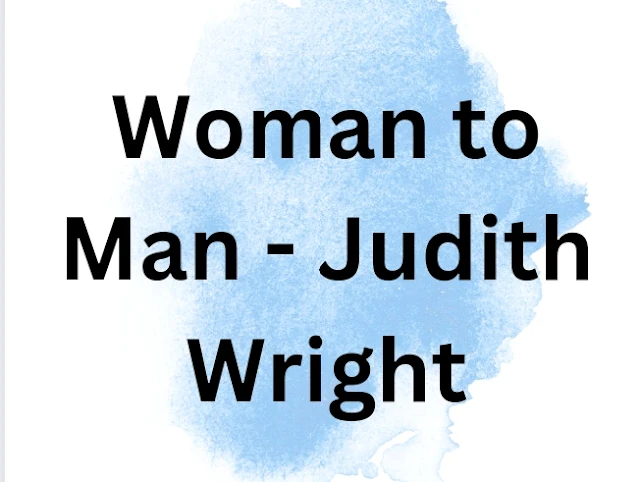Woman to Man - Judith Wright
Also read :-
- I'm Getting Old Now - Robert Kroetsch
- Refugee Mother and Child - Chinua Achebe
- The Mystic Drum - Gabriel Okara
- This is a Photograph of Me - Margaret Atwood
About Poet
Judith Wright (Arundell) (b. 1915), well-known modern Australian poet completed her education at the University of Sidney, and worked in an advertising company. She taught at the University of Queensland, Brisbane, where she was an active literary editor. Writing poetry mainly after World War II, Judith Wright combined traditional Australian imagery with modernist poetic techniques and ranked as one of the leading poets of the twentieth century. Her verse is noted for her skilful technique and is thoroughly modern in idiom. Her poetic output includes The Moving Image (1946), Woman to Man (1949), The Gateway (1953), The Two Fives (1955) and City Sunrise (1964). She was also a short story writer.
About Poetry
Judith Wright's 'Woman to Man' is an incredible poetic attempt to express the nuances of the man-woman relationship in biological metaphors and images of creativity. As a woman, she finds exact words and phrases for those beautiful images rendering both the mental and the physical in appropriate linguistic measure. This makes the poem a celebration of a woman's creativity, and her natural superiority over man. But that superiority entails the fear of responsibility for which she has to turn to the source of that delight and say 'Oh hold me'. Being a woman, she has aptly titled her poem Woman to Man', although the world stereotypically thinks of this relationship in the opposite way. Although the poem is sensual, its effect comes more through metaphors than statements. Thus without stating what the man-woman relationship is, it reveals what its essence is or should be. And all this is presented through what a woman feels within-the best of this relationship grows inside her womanhood, what the poet calls, 'the intricate and folded rose'. This is poetically reflected in the threefold rhyme pattern of each stanza of the poem.
Woman to Man
The eyeless labourer in the night,the selfless, shapeless seed I hold,builds for its resurrection day-silent and swift and deep from sightforesees the unimagined light.This is no child with a child's face;this has no name to name it by:yet you and I have known it well.This is our hunter and our chase,the third who lay in our embrace.This is the strength that your arm knows,the arc of flesh that is my breast,the precise crystals of our eyes.This is the blood's wild tree that growsthe intricate and folded rose.This is the maker and the made;this is the question and reply;the blind head butting at the dark,the blaze of light along the blade.Oh hold me, for I am afraid.
Glossary
Line 3. resurrection day restoring to life, the day Jesus rose from the grave; the day of the revival of life Line
15. intricate complex, involved
Explanatory Notes
1. The first stanza conveys what the woman feels as she visualises the union of the male and female seeds within her, which might lead to a revival of life. The moment of the union marks the day of resurrection. The creation of life is foreseen by the inward eyes of the woman. The future creation, seen in the form of light, is unknown, mysterious and therefore 'unimagined' now. That which is 'eyeless', 'selfless', 'shapeless' now will have a definite form and feature some day. The phrase 'resurrection day' attaches a sacred, religious quality to this physical union, thereby celebrating the element of divinity hidden in nature.
2. The creative principle is inevitable in human desire. Though nameless, it hunts and chases people. Its spirit always accompanies man and woman, as Jesus after his crucifixion walked with the two disciples to Emmaus. Though the two disciples had the feeling that a third person was walking with them, they did not know that it was Jesus who accompanied them. A woman always feels the presence of the third of which she is going to be the maker. This creativity which is implicit in the human blood grows like a wild tree to offer to her a complex, folded rose one day. The child is visualised today as the intricate and folded rose. In rhyming two verbs (knows, grows) with a noun (rose), the poet suggests how activity becomes an act, process becomes a product.
3. If desire is the creative principle, the two together become the maker (the plural becoming the singular); the creation (that made) makes them one. They become the question and the reply; thus the two become one. The last three lines leave the desire within to reach the outside. The lines, for the first time in the poem, become erotic in tone. The dark mingles with the light, when the blind blazes along the blade, as the speaker tells her man to hold her, so as to eliminate her fear.
4. The poem is effective because reality is captured only through metaphorical language and because of the rhythm and repetitive devices of sound. For example, the first stanza repeats 's', while the last three lines repeat 'b'. Several such examples in the poem reveal the care with which the poet has written each word.
